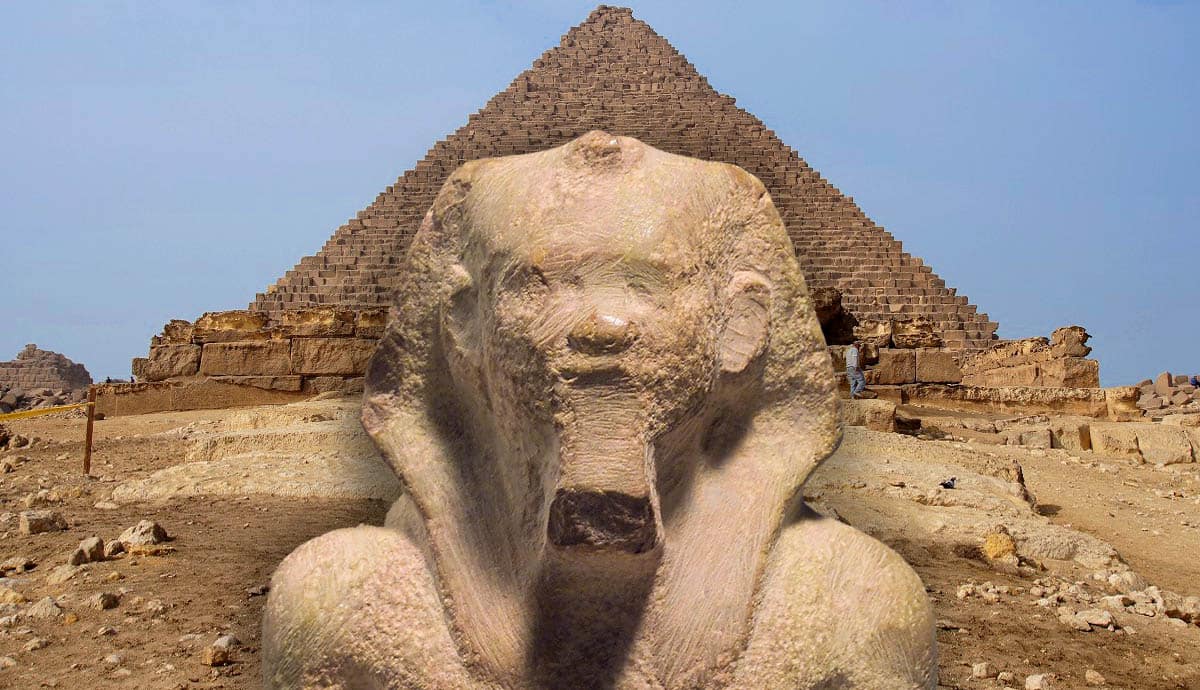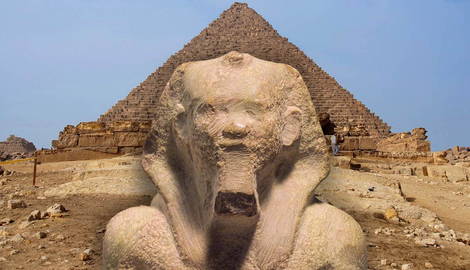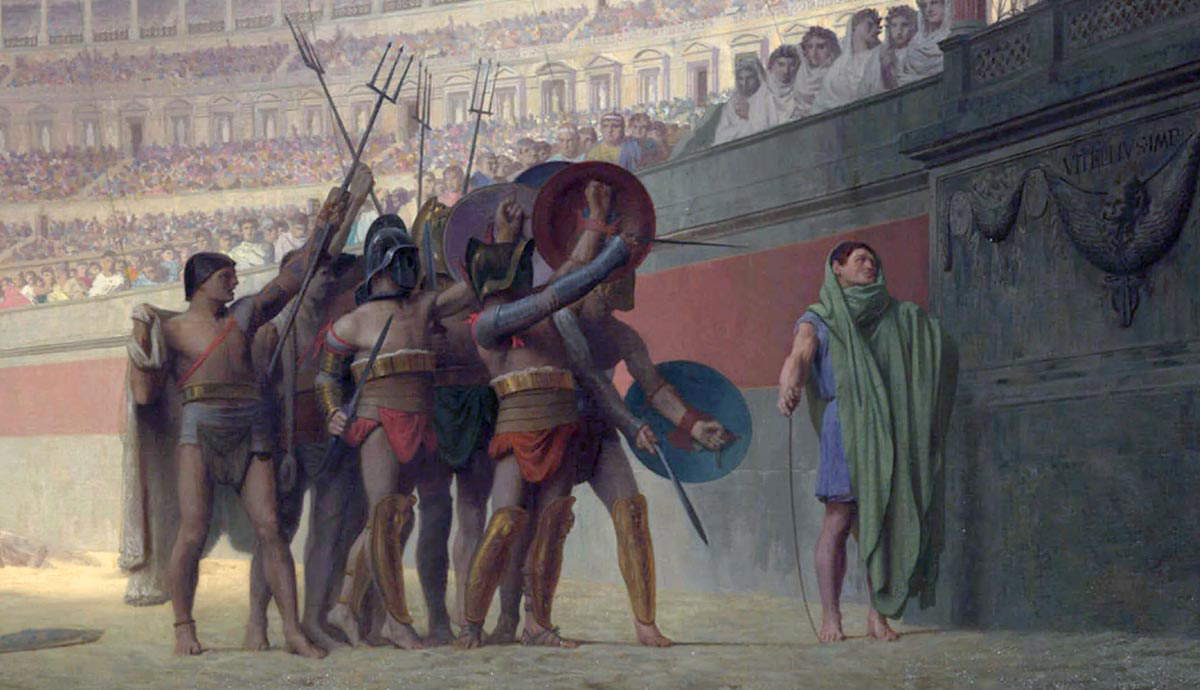
Menkaure’s pyramid may be the smallest of the well-known Egyptian pyramids of Giza, but in its day it was the most beautiful. Once covered in pink granite from Aswan, now it has a huge hole in its north face, made in the 12th century by the son of Saladin in the hopes of finding treasure inside the building. He did not succeed, and the contents of the king’s tomb only surfaced in the 19th century, only to be lost at sea while they were being transported to the British Museum. In the following article, we will explore the history of Menkaure’s pyramid.
1. The Pyramid of Menkaure

We have all heard of the Pyramids of Giza. They belong to three kings, whose names are always repeated in a specific order: Khufu, Khafre, and Menkaure. Or Cheops, Chefren, and Micerinus, in the common Greek spelling. In any case, poor Menkaure is left last, ostracized owing to his having the smallest pyramid of the three. Of course, there are many more, but compared to its neighbors, Menkaure’s funerary monument seems petty. However, sources tell us that, at the time it was built, Menkaure’s pyramid was without a doubt the most beautiful of the three.
Originally standing with a height of 65.5 meters, or 215 feet, it’s core was built out of the finest Aswan granite and limestone. Then, the lowest part of the structure was encased in red granite, and the upper portion in limestone from Tura, a stone so fine many Old Kingdom officials such as Weni considered it to be the ultimate coffin material. It was completed during Menkaure’s reign, in the 4th Dynasty, around 2,500 BCE. However, a mortuary temple which was intended to stand next to the pyramid and house cultic statues of the king was only completed by his successor, Shepseskaf. A number of additional monuments, statues, and stelae were placed in the vicinity of Menkaure’s pyramid along with other remains from the Old Kingdom.
2. Who Was Pharaoh Menkaure?

As was usual in Egypt, a society deeply concerned with family and kinship, we know more about Menkaure’s family tree than we know about his line of succession to the throne. Indeed, it is certain that he was a son of Khafre and a grandson of Khufu. It is generally agreed that he was in fact the successor of Khafre, but it is disputed, as ancient sources claim otherwise.
He had at least two wives, with whom he had at least five children, one of which came to inherit the throne after Menkaure’s death. The Turin Canon, a New Kingdom list of every pharaoh up to that date, is heavily damaged and only shows one digit in the column where the length of his reign was written: a number 8. So, it is generally accepted that he reigned for (at least) 18 years. What he did during those years is equally nebulous, apart from the various monuments and statues that he made. These statues are among the finest examples of Old Kingdom art, and arguably of Egyptian art as a whole.
3. The Pyramid of Menkaure Through History

The Giza pyramids have been known since antiquity. In fact, they were so popular in the ancient world, people considered them one of the Seven Wonders of the World. However, for millennia they remained sealed as their builders intended. Then, in the 19th Century, the craze of archaeology drew scores of wealthy explorers to the Egyptian monuments, especially the mysterious pyramids. One of the most popular theories up to that point considered the Egyptian pyramids of Giza to be Joseph’s granaries, as described in the Bible.

When Colonel Richard Howard Vyse of the British Army visited Giza in 1836, one detail of Menkaure’s pyramid caught his eye: there was a large furrow in the north side of the building, quite deep but not enough to penetrate past the solid granite structure of the Egyptian pyramid. As he quickly learned, this wound was produced by stonecutters, who were commanded to destroy the pyramid seven hundred years earlier by another powerful army. As it happened, Egypt had been conquered by the Ayyubid army of Saladin in 1171, establishing a Sultanate along the Nile. Saladin’s son, Al-Aziz, reigned after him, and embarked on an ambitious plan to dismantle the pyramids. Apparently, he was persuaded that there was treasure inside, so he ordered a number of his soldiers and stonecutters to take apart the solid blocks of the pyramid.
As Col. Vyse confirmed hundreds of years after the fact, they had been unable to make anything but small scratches to the surface. The Sultan eventually gave up, learning that this was a costly operation and had little chances of succeeding.
4. The Lost Treasures of Menkaure

Vyse and his entourage found the Egyptian pyramid of Menkaure barely scathed, and thought it a good idea to try to penetrate the old building. His method, however, did not employ brute force, as this had proved useless. Instead, he opted for carefully surveying the Giza plateau. Eventually, he came across a narrow channel that went straight into the pyramid, unfortunately not wide enough to fit a person through it. It took two months of work to widen it with the use of long poles with drill bits attached, and he finally was able to get inside the King’s Chamber. Today, it is generally accepted that this channel had ventilation purposes.
Late in 1837, Vyse discovered another, bigger opening to the pyramid, which is thought to have been made by robbers and is today the main entrance that tourists use to visit the inside of the pyramid. Unfortunately, the King’s Chamber had been robbed, the lid of the sarcophagus removed and the wooden coffin taken out for examination. Bones and pieces of mummy wrapping were found on the floor, scattered. Little was found inside the chamber, save the sarcophagus, which was too big to remove.
At this point, Vyse decided that his job was done, and returned to England, where he pursued a career as a Member of the Parliament. But the British officials that had remained in Giza had plans of their own, and they managed to painstakingly drag the heavy stone sarcophagus out of the pyramid and later load it onto a merchant ship in Alexandria, bound for England. But the wooden ship, named Beatrice, never reached her destination. She sank off the coast of Malta, taking with her to the depths of the Mediterranean sea Menkaure’s and two more sarcophagi found inside the great pyramids. Vyse never returned to Egypt, and the wreck of Beatrice has never been found.
5. Small Pyramid, Mighty Heritage

Following the excavations carried out by Col. Vyse, a great number of Egyptologists studied the pyramid of Menkaure. As it turned out, some parts of the outer casing were rough, suggesting that it was not quite finished. This may be a disappointment for tourists, but for scientists, it has been an enormous opportunity to learn exactly how the Egyptian pyramids were built. The ruins of the pyramid complex, which encompassed several satellite buildings such as the aforementioned pyramid temple, a valley temple, and three smaller pyramids have been found near Menkaure’s pyramid. Two of the “queens’ pyramids,” as they are commonly called, are unfinished, but a third one is thought to be completed. Egyptologists have speculated that these pyramids would have housed the mummies of Menkaure’s wives, and a statue of the king himself.
6. Inside the Pyramid of Menkaure

John Shae Perring, a member of Vyse’s expedition, continued the work started by the British Colonel, who should not be considered an Egyptologist but rather a keen and wealthy explorer. Perring, on the contrary, had a scientific mind, and as such, he took it upon himself to document all they found. He produced a number of highly detailed sketches, detailing the measures and position of several tunnels, corridors, and chambers inside the pyramid of Menkaure. Not only that, but he then went on to publish an extraordinarily well-documented work in three volumes, titled The Pyramids of Gizeh (1839-1842).
More recently, a project funded by the Oriental Institute in the University of Chicago set out to map the entirety of the Giza pyramids with 3D technology. Twenty years later, and despite the fact that we know much more now about what is inside the pyramid of Menkaure than Al-Aziz did in the 12th century, the Egyptian pyramid is still not entirely explored. No doubt, new finds will come in the years to follow, which promise to change the way we think about these monuments.
7. The Legacy of Menkaure and His Pyramid

As we have seen, Menkaure and his pyramid have gathered a great deal of attention throughout history. However, we know relatively little about him or his reign, and his pyramid still houses mysteries that remain to be discovered. Egyptologists can only acknowledge the fact that many of the circumstances behind Menkaure and his pyramid are lost forever, but there is still hope. Continued interest and studies conducted on the funerary monument of Menkaure have, and will certainly continue to in the future, garner enough evidence for Egyptologists to be able to paint a fairly complete picture of the Old Kingdom, one of Egypt’s most remarkable and fascinating historical periods.










